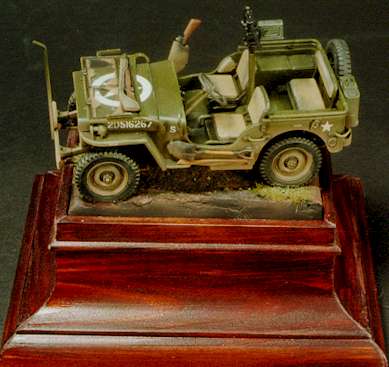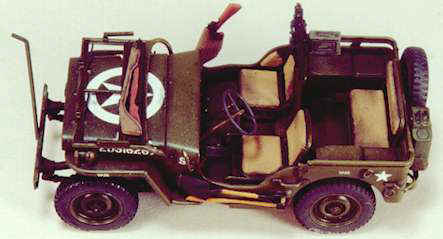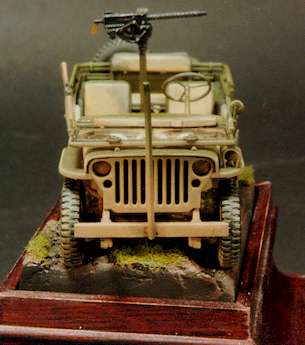Getting the most from an out-of-the box project
by Janne Nilsson
English translation by Martin Waligorski
 This is my Willys Jeep in 1/35 scale. Built directly ”outtadabox” from the Tamiya kit.
This is my Willys Jeep in 1/35 scale. Built directly ”outtadabox” from the Tamiya kit.
As the war in Europe spread in the late 1939, the U.S. Military wanted a new light-weight, four-wheel-drive, general-purpose vehicle.
While both Ford and Willys submitted the entries, the government selected a vehicle design by the Bantam Car Company. Bantam didn’t have the mass production facilities needed to supply the Army, and the military wanted multiple suppliers. Willys and Ford got contracts to build jeeps in late1940. Of the roughly half million jeeps produced during World War II, Willys-Overland made about 360,000 between 1941 and 1945.
Popular story has it that GP was the abbreviation for general purpose, but was pronounced jeep, hence the name. Other people say that the word jeep was slang for any wonderfully multipurpose thing. The Popeye cartoon had a character, named Eugene the Jeep in 1936, who had all kinds of amazing powers.
Whatever the source to the name, a legend was born. The jeeps proved to be rugged and dependable in the war, and by the time the soldiers came home, jeeps were well known and loved for their durability and unstoppability.
My project started as a demo-build under IPMS Open 98 exhibition in Stockholm. I got the kit from Kjelle from the Hobbybiten shop (thanks). I didn’t achieve much progress during the exhibition days, but continued working on it from time to time at home, and after a while the model was ready.
Working with the airbrush, I applied base color followed by shadows in a number of varying tones. Tamiya acrylics were used. Later I applied some washes with artist oils. Finally I dry-brushed the deatils to create highlights. I also used my favourite Humbrol enamels for brush-painting details.
I always try to arrange small things like spades, guns, ammo cans etc. in a manner that suggests a vehicle in daily use.
The simple base was formed with Celluclay. Various materials at hand were used for the ground structure and the foliage.
I intend to write an article about this (quite easy) project for the Swedish modelling monthly Allt om Hobby.
This article was 2000.originally published in IPMS Stockholm Magazine in December 1999


